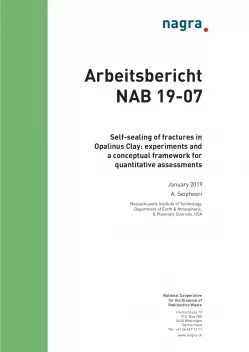
Arbeitsbericht NAB 19-07
Self-sealing of fractures in Opalinus Clay: experiments and a conceptual framework for quantitative assessments
As part of reporting for Stage 2 of the Sectoral Plan for Deep Geological Repositories (SGT), Nagra has documented the comprehensive hydrogeological and geomechanical data base and derived reference parameters for the assessment of long-term safety and engineering suitability of a deep geological repository in Opalinus Clay (Nagra 2014a,b). In this context, the current understanding of self-sealing of the fractures in Opalinus Clay has been documented, the effect on the fracture transmissivity and bulk permeability of the material was evaluated and a conceptual framework for the numerical simulation of self-sealing processes in clay-rich rock was given. Preliminary experimental evidence for the impact of compaction on the evolution of hydraulic conductivity of the Opalinus Clay was derived by laboratory tests on intact and reconstituted core samples from Mont Terri and Schlattingen, respectively (Favero et al. 2016). Since that time, complementary laboratory experiments have been launched, aimed at broadening the mechanistic understanding of self-sealing processes in fractured claystone and increasing the experimental data base. This report complements previous studies, emphasising the hydro-mechanical behavior of intact and fractured Opalinus Clay in response to stress changes in the context of a multiscale study of the pore structure and hydro-mechanical properties. The research was performed at the Massachusetts Institute of Technology (MIT) and the University of Pennsylvania (UPenn), closely coordinated with a project on the effects of burial diagenesis on Opalinus Clay behavior (Seiphoori 2019).
